|
Displaying items by tag: Warhol
The sale of the Warhols went ahead, and the works ended up as the two top-selling lots in a record-breaking auction, netting a combined $151.5 million and surpassing the pre-sale high estimate of a combined $128 million.
A year after the sale, almost to the day, the German paper FAZ reported that the proceeds were in fact used to pay off the state-owned casino's considerable debt despite previous denials. The German daily quotes WestSpiel's annual financial report that described the sale of the artworks as “an important step towards ensuring future viability."
The Andy Warhol Museum announces the public presentation of 10 rarely seen Andy Warhol "Screen Tests" on Times Square's electronic billboards from 11:57 p.m. to midnight each night in May 2015. The screenings are part of the ongoing project "Midnight Moment," a monthly presentation by The Times Square Advertising Coalition (TSAC) and Times Square Arts. Among the "Screen Tests" shown are those of Bob Dylan, Allen Ginsberg, Lou Reed, Harry Smith, and Edie Sedgwick.
Between 1964 and 1966, Warhol created almost 500 of these three-minute film portraits of famous and anonymous visitors to his studio, filming his subjects using a stationary Bolex camera loaded with 100-foot rolls of black and white 16mm film.
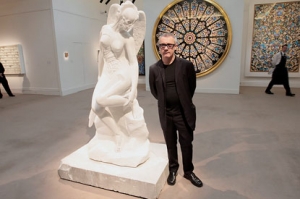
Art by Damien Hirst and Andy Warhol outperformed the Standard & Poor’s 500 index over the past 10 years, according to a new measure by Artnet AG designed to rank the performance of art as an asset.
Since 2002, Hirst’s prices have increased almost threefold, though they had risen fivefold through 2007 and have since fallen, according to a graph compiled by Artnet using its new product. Warhol has performed even better, with prices gaining fourfold and almost returning to peak 2007 levels this year. The S&P 500 has risen about 7 percent in the decade.
Art is gaining ground as an alternative investment, with many new collectors coming from the financial industry and from emerging markets, Hans Neuendorf, the Chief Executive Officer of Artnet, said in an interview in Berlin. The company’s new product is designed to help investors compare value.
“This makes investing in art much more reliable,” Neuendorf said. “Art has been a good investment over the past 10 years, but there are big differences in performance among artists. It’s more interesting to look at individual artists, in the same way that you look at stock-market segments, or individual companies.”
The art market has sustained its boom as stocks and bonds collapsed this year. While the S&P has fallen 1.3 percent, annual sales of contemporary art rose 35 percent from the previous year at the main 2011 auctions at Sotheby’s (BID) and Christie’s International, according to Bloomberg News calculations. New buyers from the U.S., Russia, Asia and the Middle East raised the bidding.
Lichtenstein, Richter
Records were set for painters including Roy Lichtenstein, L.S. Lowry, Clyfford Still and Gerhard Richter.
“There are more and more collectors, and people will pay more and more for art,” Neuendorf said. “Art as an investment form has only really been discovered in the last years.”
Hirst underperformed in Artnet’s index of the top 50 contemporary artists, which more than tripled over the decade. His prices peaked in 2007, with an average sale price of $901,214, Artnet data shows. That was a year before his “Beautiful Inside My Head For Ever” auction in London, which took $126.6 million with fees on Sept. 15, 2008, the day Lehman Brothers Holdings Inc. filed the biggest bankruptcy in history.
Thomas Galbraith, head of analytics at Artnet, said he wants eventually to refine the data even further so that investors can “compare the performance of Warhol’s Elvises versus his Marilyns,” he said. Artnet also plans to be able to compare the price of an artist’s works by medium, he said. The market reports can be purchased individually for $50.
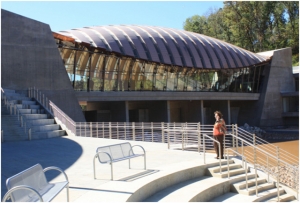
Peeking over a railing, I look down into a heavily wooded ravine where beefy buildings in concrete curve around courtyards and wrap two ponds vaulted by copper- roofed bridges.
This hidden castle is the Crystal Bridges museum, in Bentonville, Arkansas.
It houses a historical survey of American art collected in just a few years at astonishing cost at the instigation of Alice Walton, heiress to the Wal-Mart Stores Inc. (WMT) fortune.
Passing a stainless-steel tree sculpture by artist Roxy Paine, I cross a bridge to an elevator tower and descend three floors, where one of the bridges that give the museum its name opens up in front of me.
It’s a tour de force. Deep beams of yellow Arkansas pine vault overhead, rising and swelling outward like the belly of a particularly elegant whale. Light filters in from slots overhead. Outwardly slanting glass walls held together by elegant pipes, ball-joint fittings and cables pick up reflections from the wind-riffled surface of the ponds.
No art could compete with this spectacle. The vast space is used as a restaurant called Eleven and for parties.
With Walton, 62, architect Moshe Safdie chose a wooded streambed in a 120-acre swath of woodlands the family owns just north of the headquarters of the retail giant her father built. Safdie dammed the streams to form the ponds. Walton chose the generically bucolic name Crystal Bridges.
Sensual Safdie
Safdie, 73, doesn’t need to strain for grandeur; bold forms come to him naturally. He shaped balconied and arcaded gallery suites into broad crescents with draped copper roofs to echo the slope of the land. He tones down a characteristic bombast in recognition of the lovely ravine, and he achieves a lyricism and sensuality rarely found in other projects.
Tightly wedged, the 200,000 square feet (18,580 meters) of pavilions stare narcissistically at each other over the water. The Walton family has threaded the surrounding forest with pleasurable trails dotted with sculptures including a “Skyspace” installation by James Turrell.
As you enter the first two gallery suites devoted to art from the colonial era to the end of the 19th century, you encounter a collection that’s esthetically conservative and methodically assembled, including two famous portraits of George Washington (Charles Wilson Peale and Gilbert Stuart) and great painters of grand, idealized nature like Thomas Cole, Frederic Church, and Asher Durand, whose 1849 “Kindred Spirits” cost $35 million.
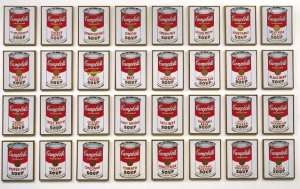
Almost 50 years ago the quintessential New York artist, Andy Warhol, had his first one- man show in Los Angeles, thanks to the prescience of a West Coast art dealer named Irving Blum.
Blum also had the uncanny foresight to snap up “Campbell’s Soup Cans,” 32 small canvases for $1,000. He would eventually sell the group for $15 million.
The paintings have returned to Los Angeles and are on display at Museum of Contemporary Art through Sept. 19, their first appearance in L.A. since they made their debut at the city’s Ferus Gallery in July 1962.
The exhibition is a tribute to the gallery, which operated from 1957 to 1966, and to Blum, one of its directors. He championed Roy Lichtenstein and Frank Stella early in their careers and gave Ed Ruscha his first solo show.
Blum, now 80, was a former Knoll Inc. (KNL) furniture salesman who bought a piece of the struggling gallery from artist Edward Kienholz and persuaded Warhol to mount his first one-man show there in 1962.
“It’s astonishing that he had the insight and courage to give Andy his first solo exhibition,” said Jeffrey Deitch, a former gallery owner who now serves as the museum’s director. “At the time it was incredibly radical. Most people refused to even accept that this was art.”
Blum persuaded the New York-based Warhol to have the 1962 show in Los Angeles by saying that “movie stars come to the gallery.”
‘They Didn’t Buy Paintings’
In reality, the few Hollywood actors and directors who collected art were European expatriates who favored French paintings, Blum said in a 1977 oral history he gave to the Archives of American Art. One exception was actor Dennis Hopper, who bought a Warhol soup can in the early 1960s and knew the Ferus Gallery crowd.
“The American movie people didn’t buy anything,” Blum said in the oral history. “They bought big motorcars and beach houses. They didn’t buy paintings.” Blum couldn’t be reached for an interview.
Blum sold six of the 20-by-16-inch Warhol canvases for $100 each. Realizing the work was more significant if the pieces were kept together, he later bought back the ones he sold.
He then negotiated a price from Warhol for all of the paintings, paying him $100 a month for ten months.
“The price sounds shockingly low, but that was the price of contemporary art in those days,” Deitch said in a telephone interview. “There was just a small band of collectors at that time.”
Blum sold the paintings to New York’s Museum of Modern Art for $15 million in 1996, in a deal that was considered partly a donation even though it was one of the highest prices paid for contemporary art at the time.

Christie’s International’s first- half sales increased 15 percent to a record, boosted by auctions of contemporary works by artists such as Andy Warhol.
The London-based company was also helped by growing private sales, demand in Asia, and a 30 percent growth in the number of successful lots. It sold 2 billion pounds ($3.2 billion) of art and antiques worldwide in January through June, the most for any half-year in sterling, Christie’s said today.
“Sales have increased across a range of departments,” Steven P. Murphy, chief executive officer, said in an interview. Lots priced between 500,000 pounds and 1 million pounds were in demand, with average selling rates of more than 90 percent, he said. “While a small percentage of clients buys for investment, we’re seeing a general cultural shift toward art,” he said.
A Warhol self-portrait priced at $38.4 million was the top performer in the first half. Contemporary art fetched 431.1 million pounds, a 40 percent increase on 2010. This was more than in 2008, though not as much as in the first half of 2007.
“The contemporary market has returned,” said Murphy. “It’s done so for a wide range of names,” he said, countering perceptions that the auctions were over reliant on established postwar artists. Works by Warhol accounted for more than $90 million of sales at its New York evening auctions in May.
Sales of modern British art and prints grew by 257 percent and 73 percent respectively. London was Christie’s biggest auction center, with 607.7 million pounds of transactions.
Private Sales
While private sales rose 57 percent to 286.7 million pounds, no single auction item exceeded $40 million. Impressionist and modern-art sales declined 30 percent. Auctions in the Americas dropped 13 percent because of a shortage of collections. In May 2010, a record $106.5 million was paid in New York for a Pablo Picasso painting from the estate of Los Angeles philanthropist Frances Brody.
Hong Kong sales grew 48 percent to 296 million pounds, consolidating Asia as the third-biggest sales center. Worldwide sales of Asian art took 356.7 million pounds, up by 45 percent.
An Asian private client was the buyer of a Michelangelo drawing for 3.2 million pounds in London on July 5. Chinese buyers continue to be the largest group at international wine auctions, which increased 107 percent to 28.7 million pounds.
It was the little luxury auction that could.
Auctioning wine, jewelry and, well, basically any high-end item, has long been commonplace online. But high-end art? That’s been (pretty much) immune to the trend — until now.
After weeks of skepticism, an online auctioneer has sold a world-famous, high-end piece of art on (gasp!) the internet — and it sold for more than its estimated value.
The piece is one of several from Andy Warhol’s 1978 “Flower” series, Mouglite has learned from a press release sent out today. The company that auctioned the 22 x 22-inch work, Artnet, said that the item sold to “a private American collector” for $1.322 million. According to several sources, many expected the work to sell for around $1.1 million. So the auction didn’t exactly knock it out of the ballpark, but it did beat expectations.
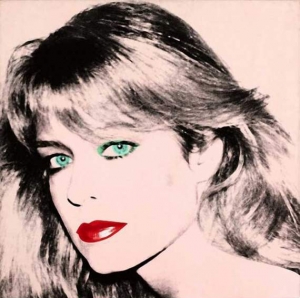
Here's some advice: If you're harboring a missing $30 million Warhol in your home, try to take it off the wall before filming an interview for your new reality show. Failure to follow this simple maxim has led a private investigator searching for a Pop Farrah Fawcett portrait straight to actor Ryan O'Neal, the late actress's longtime partner. The missing Warhol silkscreen portrait can be seen hanging above O'Neal's bed in the first episode of "Ryan and Tatum: The O'Neals," a documentary series about the actor and his daughter on the OWN network.
The investigator was hired by Fawcett's alma mater, the University of Texas, where she studied art. In her living trust, the "Charlie's Angels" star left her entire art collection to the university — but when the institution slowly began assembling Fawcett's holdings after her death two years ago, it was unable to track down one of the two portraits Warhol made of Fawcett in 1980. They are reportedly the most valuable works in her collection.
A passage in actress Tatum O'Neal's new memoir, "Found: A Daughter's Journey Home," initially tipped off the university to the portrait's whereabouts. O'Neal describes her father's home: "On every wall, there are pictures of us and the rest of the family in our golden days. The original poster from 'Paper Moon,' Andy Warhol's portrait of Farrah." Good one, Tatum.

L&M Arts gallery is serving Andy Warhol’s Campbell’s Soup in a form less familiar than the realistic red-and-white images of 1962’s Pop Art landmark.
The Manhattan gallery has assembled 12 of the 20 existing multicolored Campbell’s soup cans that Warhol painted in 1965. This is the first time they have been the sole focus of an exhibition, and the effect is remarkable.
By adding more colors to the palette, the artist transformed his original silkscreens and in the process stepped beyond his roots in the graphic arts. Greens, yellows, purples and blues fill the labels, and no one hue is identical to another in the 12 joyful paintings.
Warhol’s sharp use of color combinations gives each a painterly uniqueness where once they were only distinguished by flavor.
Two works are for sale and prices will be provided upon request. A colored Campbell’s soup can fetched $3.4 million at Phillips de Pury & Co. in 2007.
“Andy Warhol: Colored Campbell’s Soup Cans” is at 45 E. 78th St. through June 11. Information: +1-212-861-0020; http://www.lmgallery.com/.
Avedon, Gorky
Francis Bacon in black stares at visitors as they enter “Avedon: Artists” at Manhattan’s Gagosian Gallery.
The 1979 print, from an edition of 10, hangs alongside other portraits of artists, among them Duchamp, Picasso and de Kooning.
A blond dog lovingly looks up at Robert Frank, with his paw resting on the photographer’s arm. Andy Warhol shows off the scars left in his midrift by Valerie Solanas.
Also on view at Gagosian’s uptown space is a show revolving around the discovery, last year, of Arshile Gorky’s “Untitled (Pastoral),” a 1947 painting that had been hidden behind “Pastoral” -- on the same stretcher -- for more than 60 years. The exhibition focuses on the artist’s last year of life, before he committed suicide in 1948.
The challenging canvas is covered in dark brushstrokes and features an evil-looking face in the top left area with only one blue eye. In “Pastoral,” a green dog seems to be slowly stepping out of Gorky’s original yellow universe.
Not to be missed is “The Limit,” a gray abstract canvas decorated with patterns made of colors and thin lines, last shown in a retrospective at the Guggenheim Museum almost 30 years ago.
Some works are for sale, although the gallery won’t disclose prices. “Avedon: Artists” and “Arshile Gorky: 1947” are at 980 Madison Ave. through July 8 and July 1, respectively. Information: +1-212-744-2313; http://www.gagosian.com/.
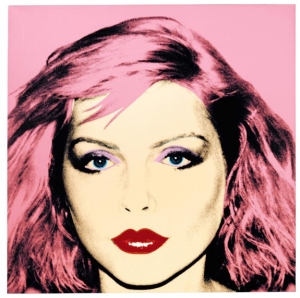
Andy Warhol’s portrait of Blondie singer Debbie Harry, and Damien Hirst spot paintings owned by Eurythmics star Dave Stewart, were today added to this month’s auction test of the contemporary-art market’s recovery.
The fruits of the rockers’ friendships with artists, to be offered by Sotheby’s in London on June 29, may fetch as much as $11.3 million. Harry, quoted in an e-mailed release by the New York-based auction house, said her portrait -- estimated at as much as $9 million -- came about after she met Warhol on Broadway in the late 1970s and they got to know each other.
“New York was a small community,” Harry is quoted by Cheyenne Westphal, Sotheby’s (BID) European head of contemporary art. “We chatted about everything. I got invited to the Factory and knew others that worked for Andy.”
Contemporary prices have been recovering after values of artists such as Hirst and Jeff Koons halved in 2009 during the financial crisis. Warhol has been seen as a safe haven for investment-minded collectors. He has become the most heavily traded contemporary artist at auction, accounting for 17 percent of all sales in 2010, according to a report by the London-based research company ArtTactic published in April.
Harry posed for one of the Pop artist’s trademark celebrity portraits. The Sotheby’s item is one of four he made of her, each 42 inches (1 meter) wide. With a formal estimate of 3.5 million pounds ($5.75 million) to 5.5 million pounds, the 1980 silkscreen is offered by a private European collector. Its sale follows the release of Blondie’s CD “Panic of Girls.”
Dockland Drunks
Songwriter and producer Stewart will be offering seven works in the auction. He met Hirst at the opening of a group exhibition in London’s Docklands in the early 1990s.
“They were giving away Beck’s beer, and so we both got really drunk,’’ Stewart said in an interview in the U.K.’s Independent newspaper in 1994. “He was incredibly confrontational. Funny. Exciting. By the end we were under the table -- had about 12 bottles each.’’
The 1994 spot painting “Dantrolene (Being God for Dave)’’ was gifted to Stewart by Hirst, who wrote a dedication on the back of the canvas. This is estimated to fetch between 600,000 pounds and 800,000 pounds. “Acridine,’’ dating from 1992 and bought directly from the artist, is valued at 400,000 pounds to 600,000 pounds. Both canvases measure more than 5 feet wide.
Fewer works by Hirst, the U.K.’s wealthiest artist, now appear at auction than during the boom. Individual prices for some works have returned to the levels of three years ago. In February, Christie’s International sold a 6-foot-wide 1994 spot painting for 881,250 pounds. A slightly larger example, dating from 1992, reached 825,250 pounds at Phillips de Pury & Co. in London in June 2008.
Stewart is also selling works by Gilbert & George, Angus Fairhurst and Andres Serrano, valued at between 12,000 pounds and 200,000 pounds.
|
|
|
|
|